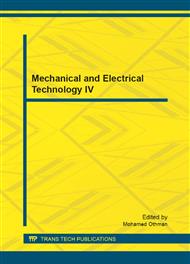[1]
Feng Xiating, Zhang Zhiqiang, Yang Chengxiang etc. Study on genetic-neural network method of displacement back analysis[J]. Chinese Journal of Rock Mechanics and Engineering, 1999, 18(5):529–533.
Google Scholar
[2]
Gao Wei, Zheng Yingren. New evolutionary back analysis algorithm in geotechnical engineering[J]. Chinese Journal of Rock Mechanics and Engineering, 2003, 22(2):192–196.
Google Scholar
[3]
Wang Denggang, Liu Yingxi, Li Shouju. Genetic algorithms for inverse analysis of displacements in geotechnical engineering[J]. Chinese Journal of Rock Mechanics and Engineering, 2000, 19(Supp. ):979–982.
Google Scholar
[4]
Gao Wei, Zheng Yingren. Back analysis of rock mass parameters based on evolutionary algorithm[J]. Journal of Hydraulic Engineering, 2000, (8): 1–5.
Google Scholar
[5]
Wen Jian-hua, LI Xin-ping, ZHANG Wen-cheng et al. A Study of Parameter Inversion of Blasting Vibration Based on Compositely Genetic Algorithm. Rock and Soil Mechani. 2005, 26(1): 160-162.
Google Scholar
[6]
Lijie Cui, Daichao Sheng. Genetic algorithms in probabilistic finite element analysis of geotechnical problems [J]. Computers and Geotechnics, 2005, 32(8): 555-563.
DOI: 10.1016/j.compgeo.2005.11.005
Google Scholar
[7]
John Kemeny, Randy Post. Extimating three-dimensional rock discontinuity orientation from digital images of fracture traces[J]. Computers and Geosciences, 2003, 29(1): 65-77.
DOI: 10.1016/s0098-3004(02)00106-1
Google Scholar
[8]
Kennedy J, Eberhart R C. Particle swarm optimization [J]. Institute of Electrical and Electronics Engineers, 1995, (11): 1942-(1948).
Google Scholar
[9]
Eberhart R C, Kennedy J. A new optimizer using particle swarm theory [J]. Institute of Electrical and Electronics Engineers, 1995, (10): 39-43.
Google Scholar
[10]
Kennedy J. The particle swarm: Social adaptation of knowledge [J]. Institute of Electrical and Electronics Engineers, 1997, (4): 303-308.
Google Scholar
[11]
TIAN Yingchun, ZHANG Zimao, WEI Peijun et al. Parametric inversion of viscoelastic media with homotopy method. Chinese Journal of Rock Mechanics and Engineering, 2006, 25(8), 1718-1722.
Google Scholar
[12]
Liao Shijun. HOMOTOPY ANALYSIS METHOD: A NEW ANALYTIC METHOD FOR NONLINEAR PROBLEMS. Applied Mathematics and Mechanics. 1998. 19(10), 957-962.
DOI: 10.1007/bf02457955
Google Scholar
[13]
Wang Ling, Yan Ming, Li Qingsheng etc. Effective hybrid optimization strategy for complex functions with high-dimension[J]. Journal of Tsinghua University(Science and Technology), 2001, 41(9):118–121.
Google Scholar
[14]
Xia-Ting Feng, Honggang An. Hybrid intelligent method optimization of a soft rock replacement scheme for a large cavern excavated in alternate and soft rock strata [J]. International Journal of Rock Mechanics and Mining Sciences, 2004, 41(4): 655-667.
DOI: 10.1016/j.ijrmms.2004.01.005
Google Scholar
[15]
W.S. Zhu, B. Sui, X.J. Li et al. A methodology for studying the high wall displacement of large scale underground cavern complexes and it's applications [J]. Tunnelling and Underground Space Technology, 2008, 23(6): 651-664.
DOI: 10.1016/j.tust.2007.12.009
Google Scholar
[16]
Qie He, Ling Wang. An effective co-evolutionary particle swarm optimization for constrained engineering design problems [J]. Engineering Applications of Artificial Intelligence, 2007, 20(1): 89-99.
DOI: 10.1016/j.engappai.2006.03.003
Google Scholar


